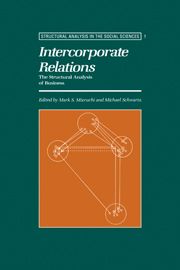Book contents
- Frontmatter
- Contents
- List of figures
- List of tables
- Introduction
- I Theoretical perspectives
- 1 A resource dependence perspective on intercorporate relations
- 2 Finance capital and the internal structure of the capitalist class in the United States
- 3 A structural approach to markets
- 4 What is money? A social structural interpretation
- 5 Corporation, class, and city system
- II National and international business structures: a comparative perspective
- Index of authors
- Subject index
5 - Corporation, class, and city system
Published online by Cambridge University Press: 04 February 2010
- Frontmatter
- Contents
- List of figures
- List of tables
- Introduction
- I Theoretical perspectives
- 1 A resource dependence perspective on intercorporate relations
- 2 Finance capital and the internal structure of the capitalist class in the United States
- 3 A structural approach to markets
- 4 What is money? A social structural interpretation
- 5 Corporation, class, and city system
- II National and international business structures: a comparative perspective
- Index of authors
- Subject index
Summary
In Ersilia, to establish the relationships that sustain the city's life, the inhabitants stretch strings from the corners of the houses, white or black or gray or black-and-white according to whether they mark a relationship of blood, of trade, authority, agency. When the strings become so numerous that you can no longer pass among them, the inhabitants leave: the houses are dismantled; only the strings and their supports remain.
Italo Valcino, Invisible CitiesIntroduction
The composition and growth of territorial communities have been theorized to depend upon their position within larger systems of such communities. Thus analyses of cities and regions have increasingly moved from focussing on attributes of places toward the study of the relations among them. In this chapter, we review past conceptions of the city system in market economies – conceptions that we argue are not appropriate for advanced Western societies like the United States. We then present an alternative conception of the US city system, examine its determinants, and consider how a city's position in this system affects its growth.
Activity without actors
Various mechanisms governing the relationships among places have been studied. Whether conceptualized as exchange, function or industry, these mechanisms are all based upon some form of activity.
In central place theory, places are linked to one another in spatially segregated, hierarchically ordered market areas. Higher-order, more central places produce for lower-order, less central places, each higher-order place exchanging its goods and services with hinterlands of ever larger extent.
- Type
- Chapter
- Information
- Intercorporate RelationsThe Structural Analysis of Business, pp. 145 - 184Publisher: Cambridge University PressPrint publication year: 1988
- 2
- Cited by



